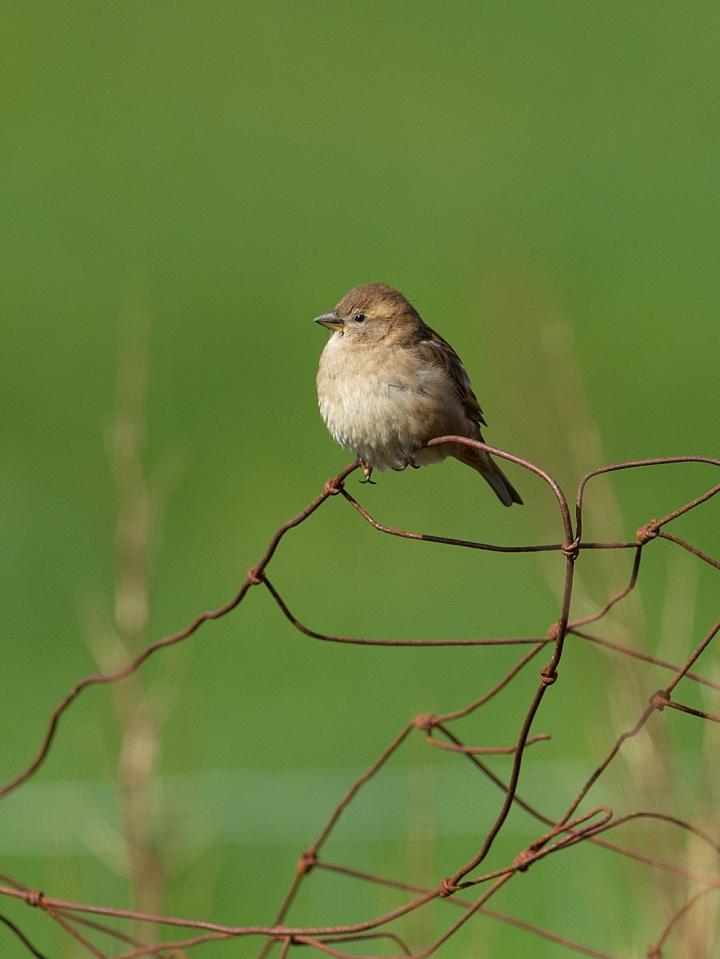House sparrows on islands in northern Norway help researchers understand fundamental biological issues.

Credit: Photo: Henrik Jensen, NTNU
Biologists have long known that inbreeding can be detrimental. Inbreeding results in less genetic variation, making species more vulnerable if changes occur that require them to adapt.
Now we know more about just how bad inbreeding really is.
“Inbreeding is equally harmful regardless of the environment,” says Henrik Jensen, a professor at the Norwegian University of Science and Technology’s (NTNU) Department of Biology.
Professor Jensen is the last author of a comprehensive study using the house sparrow as a model system. The study has now been published in the prestigious Proceedings of the National Academy of Sciences of the United States of America.
Serious consequences
The researchers examined 3100 house sparrows from eight islands along the Helgeland coast in Nordland county to see how inbreeding affected the birds.
Scientists have been investigating the sparrows on these islands for almost 30 years. They know the populations well and can follow the life of the birds from hatching to dying. This means the researchers know which birds survive from one year to the next, and how many of the young parents produce each year still alive to reproduce themselves the next breeding season.
The result is clear. Inbreeding has serious consequences.
Gene tests showed that birds with a high degree of inbreeding had shorter lives and reproduced more poorly than birds that were not as inbred. As expected, the inbred birds also had less variation in thousands of genes spread across the various chromosomes in the house sparrow’s genome.
Inbreeding means that sparrows don’t live as long and produce fewer young, regardless of the islands they are on and when they are born.
It may appear that the degree of inbreeding itself – rather than the environment the birds are in – determines how harmful inbreeding is for the individual birds.
“The more inbred the birds are, the shorter their lives and the less successful they are at producing offspring. How serious inbreeding is for a house sparrow doesn’t seem to depend on the size of the population it is part of,” Jensen says.
It comes as a surprise that the environment plays a minor role in how harmful inbreeding is. This finding goes completely against what most biologists have believed so far. The previous understanding was that the environment largely determines how detrimental inbreeding is.
Important to preserve species
The study findings could have consequences for how we preserve threatened species, since we now recognize that inbreeding is harmful regardless of the environment.
Both birds and other animals are often isolated in smaller groups, or populations, which are completely separate from other animals of the same species. Often the groups are isolated from one another due to human activity.
This is the case with lions, for example, which previously existed in large, interconnected areas that spanned several continents, but are now only found in pockets in Africa and India. This also applies to Scandinavian Arctic foxes and wolves.
“Many endangered species are struggling with inbreeding and inbreeding depression,” says Jensen.
We don’t yet know how important these factors are for the survival probability of these species and populations, nor for conserving biological diversity.
Theoretically, this could be of great importance, but in practice it is difficult to investigate how important inbreeding is relative to other genetic and ecological processes.
Small groups at greatest risk
Experts expect small groups of animals to be more susceptible to inbreeding than large populations. Fewer animals reproduce with each other, and these are likely to be related. Thus, the genetic variation will be smaller initially than in larger groups.
It is disadvantageous for these groups to become too small and receive no external influx of genetic variation.
“In our study we also found that the sparrows were generally more inbred in small populations than in large ones. Since the effect of a certain degree of inbreeding was the same in the different populations, inbreeding thus had greater significance for variation in survival and producing young in the small populations than in the large populations,” says Jensen.
For people who manage animals, it is important to keep in mind that small populations that don’t have contact with other populations may have difficulty surviving over time. These groups may be more susceptible to diseases and environmental changes.
“We have talented people on board, both at NTNU’s Centre for Biodiversity Dynamics (https:/
The researchers need to study several factors:
The genetic reasons for inbreeding’s negative effects on survival and reproduction.
The importance of dispersal of individuals between populations for inbreeding and inbreeding depression.
How inbreeding actually influences the ability to adapt to changes in the environment, and the growth rate and likelihood that populations survive over time.
Although we know a lot about this topic in theory, there are almost no studies of wild populations that have investigated these questions properly. This is partly due to the need for good data at the individual level (genetic data and information on survival and reproduction) over a long period and in multiple populations.
The sparrows on the Helgeland coast offer the possibility of collecting this information, and a lot of the knowledge gained will be transferable to other species elsewhere.
###
Source: Consistent scaling or inbreeding depression in space and time in a house sparrow metapopulation. Alina K. Niskanen, Anna M. Billing, Håkon Holand, Ingerid J. Hagen, Yimen G. Araya-Ajoy, Arild Husby, Bernt Rønning, Ane Marlene Myhre, Peter Sjolte Ranke, Thomas Kvalnes, Henrik Pärna, Thor Harald Ringsby, Sigbjørn Lien, Bernt-Erik Sæther, Stefanie Muff, and Henrik Jensen. Proceedings of the National Academy of Sciences Jun 2020, 117 (25) 14584-14592; DOI: 10.1073/pnas.1909599117
Media Contact
Henrik Jensen
[email protected]
Original Source
https:/
Related Journal Article
http://dx.




